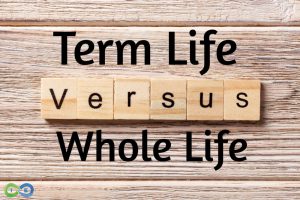Term and whole life insurance offer different advantages; which type is right for you will depend on your financial goals.
Term life insurance can provide affordable protection during an indefinite time period, such as when raising children. Plus, its premiums tend to be significantly less than whole life policies.
Cost
Term life insurance tends to be cheaper than whole life, since it provides coverage for only a specific time period, such as mortgage or college tuition payments. However, its premiums can increase each year. Meanwhile, whole life policies provide death benefits that last throughout your entire lifetime and feature cash value components which accrue interest tax-deferred.
Whole life insurance is an ideal solution for high-net-worth individuals who wish to leave behind an economic legacy for their loved ones after they are gone, while it also provides a safe and reliable means of diversifying retirement savings if their IRA or 401(k) accounts have reached maximum capacity.
Whole life insurance can also be an ideal choice for parents of special-needs children, providing them with an inheritance payment if they pass before reaching adulthood, helping cover day-to-day expenses and long-term care costs. It should be noted, though, that this policy doesn’t take all your financial needs into consideration such as income replacement; furthermore it requires long-term commitment and often includes a medical exam.
Coverage
Term life insurance offers individuals a flexible solution that enables them to customize their coverage to their unique needs. With flexible term lengths and coverage amounts available, selecting a policy to fit your timeline – be it protecting children as they grow up, covering mortgage debt, medical bills or any other expense is simple with term life. Plus it tends to be cheaper than whole life!
Whole life insurance provides lifetime protection, guaranteed death benefits and an accessible tax-deferred savings account that builds cash value that you can access or borrow against. Though more costly than term life, whole life may provide families with financial security for generations.
Term life insurance provides temporary protection for an agreed upon period, usually 10-20-30 years. It is typically used to fund college educations for children or cover funeral costs and debt payments. As an affordable way of giving loved ones peace of mind and helping you achieve financial goals, term life is an ideal solution for those worried about outliving savings or investing in the stock market.
Cash value
If you want to provide a lump-sum death benefit for your beneficiaries following your death, term life insurance may be your best bet. Whole life policies tend to offer higher death benefits but may cost more. Furthermore, whole life policies come equipped with cash value components which allow you to borrow against or withdraw money tax-deferred. This feature could prove invaluable should your retirement savings fall short after maxing out existing IRA and 401(k) contributions.
Whole life insurance offers many advantages, such as dividend payments and guaranteed interest rates, that could make choosing it over another type of permanent coverage more tempting. But remember there’s no single solution to life insurance; an advisor can help evaluate your family’s needs to identify which policy type would work best in your situation.
Term life insurance tends to be cheaper than whole life coverage because it only lasts a limited amount of time and pays out only upon your death before its expiration. Whole life policies on the other hand tend to be more costly as they cover your entire lifetime with cash value accumulation; many opt for whole life policies nonetheless in order to secure their loved ones’ financial futures.
Taxes
Term and whole life insurance both offer different forms of protection with their own specific advantages and drawbacks. While term life is an affordable choice for a specific period, while whole life provides lifetime protection and builds cash value over time. Your decision on a policy type should depend on your family’s needs and financial goals; discuss all available options with a qualified professional prior to making a final decision.
Term life policies differ from whole life policies in that they do not include an investment component, so death benefits are the sole payout. Furthermore, most term policies require a health exam which could increase premiums or lead to denial of coverage in the future. Conversely, whole life policies offer permanent coverage with an investment account earning guaranteed returns over time.
Another key difference between term and whole life policies is that whole life policies offer you access to borrowing against their accumulated cash value, withdrawal tax liability for withdrawal. Term life policies do not permit this option.
Based on your needs and circumstances, either option could be suitable. Term life offers affordable protection for specific periods while whole life insurance typically offers more features that could prove valuable over time.



